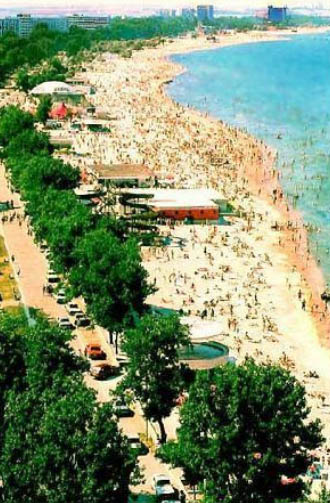Romania's coastal erosion
According to a report about the causes and responses to Romania's coastal erosion issues available at http://www.ice.org.uk/ICE_Web_Portal/media/Events/Breakwaters%202013/Causes-and-Responses-to-Romania%E2%80%99s-Coastal-Erosion-Issues.pdf, Romania has an entry at the Black Sea Coastline for a shoreline of 240 Km. Mamaia, Eforie Sud, Eforie Nord, Costinesti, Constanta, Jupiter, Venus are some of the major Romanian beaches which attract thousands of people every year, both foreign and domestic.
Apart from the inputs from the Danube, there is little contemporary supply of sediment to the coast. Certain areas of the shoreline are subject to significant erosion risks. Thus, erosion occurs primarily because
- of major port developments that interrupted sediments movements on the coast
- extension of the river Danube training walls improving navigation but with a significant impact on existing sedimentation patterns
- changes in sediment supply to the coast from the river Danube brought about by dams constructed

According to http://www.eurosion.org/shoreline/45mamaia.html, Mamaia is the biggest
seaside tourism resort in Romania which has one of the most attractive
touristic beaches from the southern part of the Romanian Black Sea Coast.
It is located close to Constanta city on a narrow sand bar of about 250-350
m width and 8.5 km beach length between Siutghiol Lake (in the west) and
the Black Sea (in the east).
Coastal erosion is
a particular problem at Mamaia, due to the Midia harbour extension dikes
which act as a barrier to longshore currents running from north to south.
Unfortunately, erosion is an accelerating process in this area and represents
a high risk for the beach environment and related human activities (tourism).
The morphological evolution of the beach is influenced also by the diminution
of the alluvial sediments discharged by the Danube into the Black Sea
and by the extension of Sulina jetties and development of Constanta -
South Agigea Port as well which have modified the natural currents and
wave regime. The new configuration of the Romanian coast, together with
a lessening of sediment loads, contributed to the disturbance of nearshore
sedimentary processes and has resulted in an increasing erosion in the
southern part of the coast, particularly on Mamaia beach.
Severe storms
in 1981, 1986 and 1988 have aggravated the erosion process, particularly
in the southern part of Mamaia beach. Significant damage has occurred
to beach developments and some hotels have been endangered. Coastal defences
were built starting with 1989, consisting of 6 breakwaters (to a depth
of 5 m) running from the south to the centre of Mamaia beach. In addition,
artificial nourishment was undertaken with sand taken from Siutghiol Lake
and placed on 1.5 km of beach behind the breakwaters. Although shoreline
retreat was stopped directly in front of the breakwaters, erosion rates
nevertheless increased immediately northward of the protected beach area.
What is Romania doing to prevent coastal erosion and alert people?
Coastal defense and beach control structures took place during the 1970s' and 1980s but are generally in poor condition due to lack of maintenance investment. And the poor condition of these defense structures unfortunately allowed beaches to deteriorate significantly.
Clearly, Romanian authorities need to do a lot more in order to prevent the coastline which is a magnificent asset attracting thousands of tourists both national and international.

Also, do you know what is the erosion rate? (I'm trying to get an idea of how bad it is...Marina losses 1m sand along the coast/yr in some places...that is pretty big..)
ReplyDelete
DeleteFrom what I read erosion rates are generally in the order of 2 m/year on the Romanian coastline, which should be considered pretty serious. I also read that Data show that the annual average modification rate of the shore line was of -2.3m/year, with oscillations between +7.8 m/year (Melody Hotel) and -10.4 m/year (Riviera Hotel) (2). I found quite a lot of significant information on http://www.climateadaptation.eu/romania/coastal-erosion/.
yes, all those numbers are pretty significant...that 'Riviera Hotel' case is pretty extreme...
DeleteIt does not surprise me they have coastal erosion problems but it did that they do not seem to have a current plan to address it (and they are getting a lot of tourism so if for nothing else, you'd think that they'd want to keep their 'beaches' perfect and wide...
ReplyDeleteThe massive development of tourist resorts along the southern part of the coastline has created a ‘vicious circle’ in the coastal assets that have required protection, which in turn has generated negative side effects, especially with respect to sediment dynamics. These coastal and river engineering works include embankments along the entire Danube basin and dams in the river that generated a reduction of sediment supply to the coast of over 50%, measures such as meander cut-offs and embankments in the Danube Delta, and ‘hard’ coastal protection works (harbour jetties, seawalls, groins, etc.). Artificial beach nourishments have only been applied on a small, experimental scale. Most of the beaches of the southern part have been artificially stabilized (almost 22% of the southern coastline); and erosion rates are generally in the order of 2 m/year. Cliff erosion rates in the southern part are 0.3-0.7 m/year (1).
Delete1-2m/yr is a similar average rate to our erosion rates in Monterey...
Delete